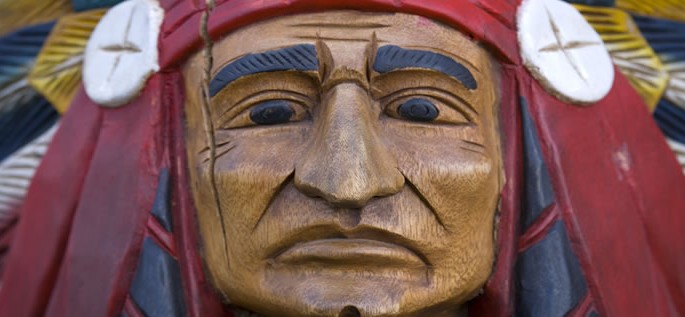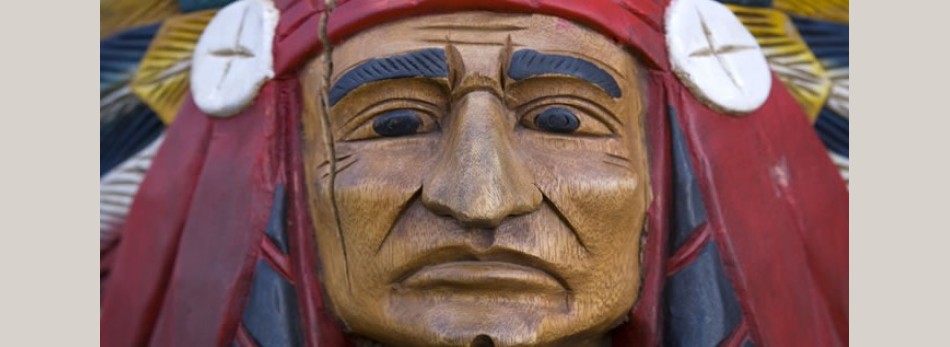Cherokee

Cherokee (Tsalagi) belongs to the Iroquoian language family. The name of the language occurs in several forms. The form Cherokee came from the Eastern, while the form Tsalagi came from the Western dialect. Today, all Cherokee people refer to themselves as tsa-la-gi. Cherokee speakers constitute the seventh-largest group of speakers of native languages north of Mexican border. It is spoken by 15,000 to 22,500 people in eastern and northeastern Oklahoma, Cherokee Reservation; Great Smokey Mountains; and western North Carolina (Ethnologue). Linguists believe that the Cherokee people migrated to the southeast from the Great Lakes region about three thousand years ago. Despite the three-thousand-year geographic separation, the Cherokee language today still shows some similarities to the languages spoken around the Great Lakes, such as Mohawk, Onondaga, Seneca, and Tuscarora..
In 1540 the Cherokee lay claim to a 40,000 square-mile territory that today partly includes the states of Alabama, Georgia, North Carolina, South Carolina, Virginia, West Virginia, Kentucky and Tennessee. In the late 18th century, some Cherokee were paid a fee to voluntarily migrate west, but most of them remained on their ancestral lands. In 1838, under pressure from white settlers, Andrew Jackson ordered a forcible removal of some 20,000 Cherokee to Oklahoma, the home of The Cherokee Nation today. Several thousand died along the way, and the forced march became known as theTrail of Tears. The journey is called in Cherokee nu-na-hi du-na tlo-hi-lu-i‘trail where they cried’. Several hundred Cherokee evaded removal by hiding in the mountains of North Carolina. In 1842, they received permission to remain on lands set apart for their use in western North Carolina. These lands today constitute the Qualla Reservation.
Status
Despite the relatively healthy size of the ethnic population, Cherokee is an endangered language. Only about a hundred monolingual speakers of Cherokee are still living. However, increasing numbers of Cherokee descendants are renewing interest in the traditions, history, and language of their ancestors. In some communities in eastern Oklahoma and western North Carolina, Cherokee is now used by speakers of all ages.
Dialects
At the time of European contact, there were three dialects of Cherokee: Lower, Middle, and Overhill. The Lower dialect which was spoken primarily on the South Carolina-Georgia border, has been extinct for over 200 years. Of the remaining two dialects, the Middle dialect (Kituwah) is spoken by the Eastern band on the Qualla Boundary. The Overhill or Western dialect is spoken by some 9,000 people in Oklahoma. The Western dialect is more widely spoken and written than the Eastern. Both dialects have been influenced by English, with the Western dialect showing some Spanish influence.
Structure
Cherokee has a relatively small inventory of phonemes.
Vowels
Cherokee has 6 vowels which can be either short or long. Vowel length distinguishes the meaning of words. In writing, vowel length is represented by a colon after the vowel. The language has one somewhat unusual vowel: a nasalized schwa /ə̃/ which is represented in writing by the letter v. There is only one diphthong, namely /ai/.
|
Front
|
Central
|
Back
|
|
|---|---|---|---|
| Close |
i, i:
|
u, u:
|
|
| Mid |
e, e:
|
ə̃, ə̃:
|
o, o:
|
| Open |
a, a:
|
- /ə/ = a in about, only nasalized
Consonants
There are 10 consonants in North Carolina Cherokee. Like other Iroquoian languages, Cherokee lacks the labial sounds /p/, /b/, /f/, /v/. The only labial sound is /m/ which occurs only in a few native words and in loanwords from English.
|
Bilabial
|
Alveolar
|
Palatal
|
Velar
|
Glottal
|
|
|---|---|---|---|---|---|
| Stops |
d
|
g
|
ʔ
|
||
| Fricatives |
s
|
h
|
|||
| Affricates |
ts
|
||||
| Nasals |
(m)
|
n
|
. | ||
| Lateral approximant |
l
|
||||
| Approximants |
w
|
j
|
- /ʔ/ = sound between the vowels in uh-oh, represented by an apostrophe in writing
Pitch accent
Cherokee syllables may be marked by low, mid, or high pitch in addition to one falling and two rising pitches. However, linguists have not yet reached a consensus about the nature of Cherokee pitch accent. Pitch is usually not marked in writing.
Like many Native American languages, Cherokee is polysynthetic, meaning that many morphemes may be linked together to form a single word. A single Cherokee word may be equivalent to an entire clause in English, e.g., gawonisgo which means ‘he speaks all the time’.
Nouns
- Cherokee nouns belong to one of two classes: animate and inanimate. All people and animals are animate, and with only a few exceptions, all other nouns are inanimate.
- Animate and inanimate nouns are distinguished by different forms of the modifiers, e.g., in the singular: dalonige nvya ‘yellow rock’, and adalonige tsisgwa ‘yellow bird’; in the plural didalonige nvya ‘yellow rocks’, and anidalonige tsisgwa ‘yelow birds’.
- Animate and inanimate nouns take different forms of the verb, e.g., sgwahlesdi tsigowtiha ‘I see a ball’, gihli tsigowtiha ‘I see a dog’ in the singular and disgwahlesdi detsigowtiha ‘I see balls’, gihli gatsigowtiha ‘I see birds’ in the plural.
- Nouns are derived from verbs by using derivational suffixes. For instance, the agentive suffix –i is used to derive the noun gawonsisgi ‘speaker’ (literally, ‘one who often speaks’) from the verb gawonisgo ‘he speaks all the time’.
Pronouns
Cherokee personal pronouns are prefixed to nouns. There is an inclusive and an exclusive form of the first person plural ‘we’. The inclusive form includes the listener, while the exclusive form does not.
| Inalienable (those expressing permanent traits or qualities) | |||
|---|---|---|---|
|
singular
|
dual
|
plural
|
|
| 1st person |
tsi– ‘I’ tsi-yvwiya ‘I am an Indian’ |
ini– ‘you and I’ ini-yvwiya ‘You and I are Indians’ |
idi– ‘we’ (inclusive); otsi– ‘we’ (exclusive) idi-yvwiya ‘We (including you) are Indians’ otsi-yvwiya ‘We (excluding you) are Indians’ |
| 2nd person |
hi– ‘you’ hi-yvwiya ‘you are an Indian’ |
sdi– ‘you two’ sdi-yvwiya ‘You two are Indians’ |
itsi– ‘you’ (more than two) itsi-yvwiya ‘You all are Indians’ |
| 3rd person |
a– ‘he, she’ a-yvwiya ‘he/she is an Indian’ |
osdi– ‘he/she and I’ osdi-yvwiya ‘He/she (not you) are Indians’ |
ani– ‘they’ ani–yvwiya ‘They are Indians’ |
| Alienable | |||
|
singular
|
dual
|
plural
|
|
| 1st person |
agi– ‘I’ agi-tsi ‘my mother’ |
igini– ‘you and I’ igini-tsi ‘our (the two of us) mother’ |
igi– ‘we’ (inclusive); otsi– ‘we’ (exclusive) igi-tsi ‘Our (including you) mother’ otsi-tsi ‘We (excluding you) mother’ |
| 2nd person |
tsa– ‘you’ tsa-tsi ‘your mother” |
sdi– ‘you two’ sdi-tsi ‘Your (the two of you) mother’ |
itsi– ‘you’ (more than two) itsi-tsi ‘Your mother” |
| 3rd person |
u– ‘he, she’ u-tsi ‘his/her mother’ |
ogi– ‘he/she and I’ ogi-tsi ‘His/her (but not your) mother’ |
uni– ‘they’ uni–tsi ‘Their mother’ |
Verbs
- Cherokee verbs are quite complex. They consist of a root plus a number of prefixes and suffixes that must be kept in a strict order. Here is an example from Wikipedia.
|
ge:ga
|
|||
|---|---|---|---|
|
g-
|
-e:-
|
-g-
|
-a
|
|
prefix
first person singular |
root
‘to go’ |
suffix
aspect marker |
suffix
present tense marker |
|
‘I am going.’
|
|||
- Verbs are marked for tense, aspect and mood.
- There are many different prefixes and suffixes which allow many many possible combinations, so that Cherokee verbs potentially have thousands of different inflected forms. For example, yi-tsi-gata-ha ‘I don’t know’ consists of yi– ‘negative prefix’ + –tsi– ‘I’ + –gata– ‘know’ + –ha ‘present tense’.
Word order
The normal word order in Cherokee is Subject-Object-Verb. Modifiers generally precede the nouns they modify.
Vocabulary
Cherokee tends to rely on its own linguistic resources rather than on loanwords. For instance, instead of borrowing the word for ‘airplane’ from English, Cherokee created the word tsi-yu ga-no-hi-li-to-hi, literally ‘the thing that one flies’.
Here are some common words and phrases in Cherokee.
| Hello, welcome | si-yo, o-si-yo |
| Goodbye | do-na-da-`go-v-i (to 1 person); do-`da-ga-g`hv-i (to a group) |
| Thank you | wa-do |
| Please | u-do-hi-yu-i |
| Yes | v-v |
| No | tla |
| Man | a-s-ga-yv |
| Woman | a-ge-yv |
Below are the Cherokee numerals 1-10.
| 1 | 2 | 3 | 4 | 5 | 6 | 7 | 8 | 9 | |
| saqwu | ta’li | tso’i | ngvi | hi:sgi | sudali | galiquo:gi | tsune:la | sone:la |
Writing
Cherokee was one of the first American Indian languages to have a writing system devised especially for it. In 1821, the Cherokee tribal council approved a Cherokee syllabary created by Sequoyah, a Cherokee speaker who knew only a few words of English. Using printed alphabets of other languages given to him by missionaries, he created a Cherokee syllabary with 85 letters adapted from English, Greek, and Hebrew alphabets. Each symbol represents a syllable usually consisting of a consonant and a vowel. The syllabary is no longer in public use, although there are efforts to revive its use for a greater variety of purposes.

Below are Cherokee numerals 1-10.
| 1 | 2 | 3 | 4 | 5 | 6 | 7 | 8 | 9 | 10 |
| saqwu | ta’li | tso’i | nvgi | hi:sgi | sudali | galiquo:gi | tsune:la | sone:la | sgohi |
Take a look at Article 1 of the Universal Declaration of Human Rights in the Cherokee syllabary and in transliteration.
| ᏂᎦᏓ ᎠᏂᏴᏫ ᏂᎨᎫᏓᎸᎾ ᎠᎴ ᎤᏂᏠᏱ ᎤᎾᏕᎿ ᏚᏳᎦᏛ ᎨᏒᎢ.ᎨᏥᏁᎳ ᎤᎾᏓᏅᏖᏗ ᎠᎴ ᎤᏃᏟᏍᏗ ᎠᎴ ᏌᏊ ᎨᏒ ᏧᏂᎸᏫᏍᏓᏁᏗ ᎠᎾᏟᏅᏢ ᎠᏓᏅᏙ ᎬᏗ. |
| Nigada aniyvwi nigeguda’lvna ale unihloyi unadehna duyukdv gesv’i. Gejinela unadanvtehdi ale unohlisdi ale sagwu gesv junilvwisdanedi anahldinvdlv adanvdo gvhdi. |
| All human beings are born free and equal in dignity and rights. They are endowed with reason and conscience and should act towards one another in a spirit of brotherhood. |







